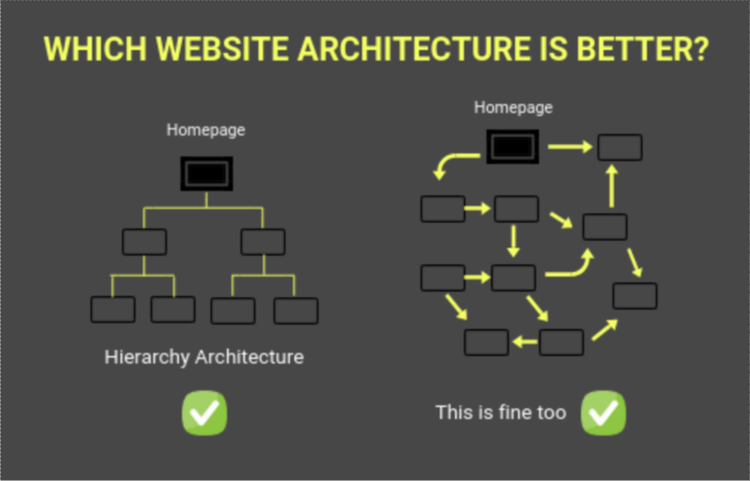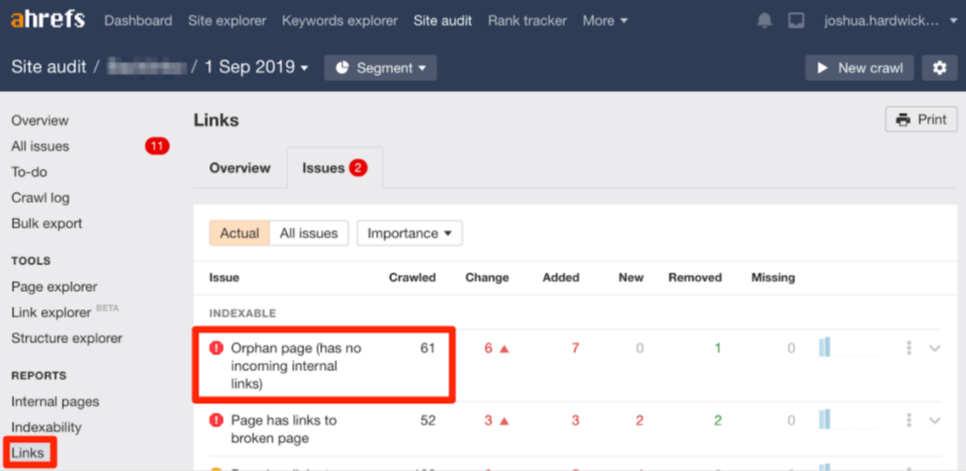One of the first things we learn in SEO when introduced to it is on-page optimization which includes the organization of heading tags(H1, H2, H3). Developing a site structure is a crucial act of the organization of a website. It has this simple goal of creating a site that is easily navigable by users and also allows easy crawling for search engines.
Think of those hallways present in your house. You can have this analogy with the rooms and hallways present in your house. You need hallways to find access to other rooms in your house. Similarly, you need links to pages in your website by which users and search engines can find your page easily.
One of the crucial elements of building a clear site architecture is linking the internal pages of your website. This can be done by linking internally via the body content and through navigational items. In this way, the hierarchy of your website can be established providing link value for the most important pages and content, thereby boosting your SEO.
This is a major factor that most marketers tend to neglect and uphold backlinking as the main factor to evaluate the quality of a website for ranking purposes. Which is wrong, internal linking is as important as backlinking for an evergreen SEO strategy that should be practiced by every search engine marketer out there.
What is Internal Linking?
Simply put, internal linking occurs when you link one webpage to another of your website. To put it in more detail, internal linking is the act of hyperlinking the content of one webpage to other pages of the same domain.
However, you must also note that it must look very much natural and not deliberate. If it is overdone, you could face consequences such as penalties, etc. Hence, you need to have a spot-on internal linking strategy on your website.
Apart from the links on your homepage, menu, blog, etc you can also add links in your content, something called Contextual Links. When your user navigates through your content and finds links to other interesting and more importantly, relevant and related content on your site, it would build more viewing time & in turn gain their trust. This helps determine the value of that content.
Internal Linking vs External Linking
While internal linking connects pages and posts on your own website, external links connect your pages to other websites. External linking may sound contradictory as you might not want your users to click on links that would direct them away from your site. But, linking to trustworthy and authoritative sites helps you appear to be an authoritative site as well. And if your content is unique and valuable, other websites also would link to your websites as a source for their own blog. These links also help in boosting your search engine rankings to a great extent.
Why is Internal Linking Important for SEO?
Conceptually, there are 2 primary considerations you need to make when strategizing your internal link structure.
- Users – Make your website easy-to-navigate for your users so that they could pass through as efficiently as possible.
- Search Engines – how the search engine spiders will crawl your website and find the internal linking structure.
You need an internal linking strategy that would cater to both these parties successfully and make them happy.
Here is why internal linking is essential for SEO in 2020
Easy website navigation
Every reader lands up on your website with some personalized intention. Some are here to look for some information, some are looking for your product or service and some just want to get in touch with you.
Your job as a site owner is to make their life easy by providing a good user experience. You have full control of your site administration and you can design the exact reading path and navigation experience for the visitors on your website. And of course, search engines consider and appreciate websites that provide a great user experience.
Building a Website Architecture
A website hierarchy can be established, but very importantly, you need to create a website architecture to fulfill your user intent. This could be the best way of forming a site architecture. Hence, both ways of creating a website architecture would work just fine as shown below.

Distributing Link Equity throughout the website
Your link equity or link juice can be transferred throughout pages on your website via internal linking. For example, if you have published some new content recently, you can link the high-performing pages on your website to this content that would help search crawlers to find and index this new content.
Keep Your Readers Glued to your Website
Which means, low bounce rate. The more time your visitors spend on your website, the lesser bounce rate you will have. Presenting them with multiple relatable & valuable content options can get you their attention and trust which could lead to following and converting. It can also have a major impact on search engine rankings.
Makes Crawling & Indexing easier for Search Engines
Building a strong internal site architecture is imperative for search engines to crawl and discover your content. The pages which are not often visited can be linked with other popular pages so that it is easier for bots to crawl and index your content. Also, it can help you in ranking better.
Industry’s Best Tools to find Internal Link building Opportunities
Let’s look at some popular tools and its usability in building a strong internal site structure
Ahrefs
One of the industry’s leading tools, Ahrefs has a plethora of useful features when it comes to link building. It launched this feature in 2020 and shows the internal linking structure for your site, the link building opportunities for pages with lesser links, and the ones which are highly performing due to its internal linking.

You’ll find it in the Ahrefs Site Audit tool. You can detect and fix all issues related to backlinking and internal linking.
Identify broken internal links
After you are done running the site audit, head to the issues tab which would show all the broken internal links of your site.

The 4XX page error highlights all the pages with broken links. You can also sort the pages with lots of internal links pointing to them by prioritizing from high to low.
Internal links to redirected pages
The redirects report is the best way to view the pages hitting too many redirects(3XX).

High amount of internal links to insignificant pages
The 2XX redirect response code report shows the working pages on your site. If you skim the list you can find unimportant pages with lots of internal links. You can go ahead and eliminate them.
Deep-linked important pages
This report shows the important ie. the ones from which you earn conversions and target a worthy keyword that is not more than 3 clicks away from your seed/home page. You can sort them by ‘Depth’ and view how far are those pages from your seed page. By knowing that, it would be wiser to bring those pages closer to the seed page.
And most importantly, you can find orphaned pages with no incoming links by applying the filter in the Issues tab. Make sure that no important pages are left in this section, and if it lies then it needs to be corrected on priority.

Screaming Frog
This is another state-of-the-art tool that helps you find all information about internal as well as external links and rectify site structure errors with interactive visualizations.
You can basically extract it all from the Configuration menu. If the content is all you need to check then you can head to Configuration > Custom > Extraction/Bulk Export and deselect all other options such as JavaScript, Flash, CSS on the menu, and bulk export a CSV file of ‘All Links’.
This can be a big report especially if it is a large site, but you can sort and tally the links for each page by going to the ‘Internal’ tab and clicking ‘Outlinks’. There is pretty much every function of checking the link building structure that is covered in this tool like – viewing broken internal/external links, comprehensive view of redirects (Response Codes), and internal link building opportunities for a good distribution of link juice.
Rest of the work on data, however, needs to be conducted on your spreadsheet.
Hack (Source: seerinteractive.com): VLOOKUP between 2 export files to match the Source & Destination columns with the final URL location.
Sample formula:
=VLOOKUP([@Destination],’response_codes_redirection_(3xx).csv’!$A$3:$F$50,6,FALSE)
(Where ‘response_codes_redirection_(3xx).csv’ is the CSV file that contains the redirect URLs and ‘50’ is the number of rows in that file.)
It also has two types of visualizations – the crawl and the directory tree visualization.
The Crawl tree graph shows a single shortest path to a page from the start URL. But they don’t show every single internal link as it makes visualizations hard to scale.

The force-directed crawl diagrams have a start URL represented by the dark green node and the lines represent the links between one URL and another by the shortest path.

The indexable pages are highlighted in green and the pastel red ones are the problematic sections or pages on the website. This makes it helpful in quickly identifying areas of interest to dive into further.
Final Thoughts
SEO is indispensable for any growing online business and the right strategy is key. You’re missing out on rankings and your potential audience if your internal linking structure isn’t rightly set up.
Read on this wonderful case study by Ninja Outreach wherein their internal linking SEO campaign got them an increase of 40% in organic traffic.
However, it should be focused on improving your website UX to the core and thereby the SEO benefits would flow in naturally.
Is there anything we missed out? Let us know in the comments!
Agile SEO Services in town!
We know our craft and deliver prompt and proficient services with a transparent procedure so that our clients are the most benefited at the end of the day!
Contact Us Today to know more!



